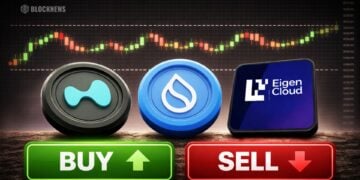- Hedera Hashgraph is partnering with the U.S. Federal Reserve’s FedNow system, offering fast, low-cost, and 24/7 micropayments through Dropp—giving it a real edge over other chains chasing government adoption.
- Unlike typical blockchains, Hedera uses a unique consensus mechanism called Hashgraph (aBFT) and is governed by major players like Google and IBM, making it fast, energy-efficient, and institution-ready.
- With the FedNow integration expanding and real-world adoption growing (e.g., Hyundai, Kia, carbon tracking), Hedera is quietly becoming one of the most credible U.S.-based crypto networks in 2025.
Even with all the market ups and downs lately, there’s still one topic heating up under the radar: Made-in-USA crypto projects. We’re talking about a space worth close to $400 billion—yeah, that’s billion with a B. And one project is quietly climbing to the top of that list. Heard of Hedera Hashgraph? If not, don’t worry. You’re not alone. But maybe you should be paying attention.
Because here’s the thing—they’ve got a deal with the U.S. government. And that’s not just hype. It’s real, and it’s happening now.
Hedera Isn’t Like the Other Chains
Let’s back up a second and talk about what makes Hedera so… different.
- It’s private and permissioned. Only approved big-name partners can run validator nodes. We’re talking names like Google, IBM, and Chainlink. Not your average anonymous node operators.
- And guess what? It’s not even a blockchain. Hedera runs on something called Hashgraph. Imagine a room full of people all gossiping at the same time, and somehow the truth still floats to the top. That’s the idea behind how consensus works. It’s a method called aBFT—Asynchronous Byzantine Fault Tolerance.
No mining. No proof of stake. Just really fast, low-energy consensus that’s almost impossible to mess with.
FedNow + Hedera = Huge
Now here’s where things get interesting.
The Federal Reserve launched FedNow in mid-2023—a 24/7 instant payments system. Unlike ACH (which takes forever), or SEPA (still slow), FedNow clears transactions in seconds, even on weekends. It’s basically banking, with crypto-level speed.
And guess who’s been working with them since day one? Yep. Hedera.
It started with a micropayments integration via a project called Dropp (built on Hedera), but this isn’t just about tipping content creators. The Fed picked Hedera because:
- ⚡ It’s blazing fast
- 💱 It supports USD, USDC, and even HBAR
- ✅ It’s credible—Google doesn’t partner with just anyone
So while everyone’s out there shouting about XRP working with the government (spoiler: it’s mostly just noise), Hedera’s actually doing it.
Hedera’s Use Case Is Real—and So Is the Growth
Aside from being part of the FedNow sandbox, Hedera’s tech is already in use with major names like Hyundai and Kia—for stuff like carbon tracking, no less. And now that the U.S. government has a working relationship with the network, it opens up a lot more possibilities.
This isn’t some vaporware situation. This is real-world adoption—and it’s happening now.
And sure, the Fed has to stick with traditional banks. That’s the whole point of FedNow. But that doesn’t mean they can’t test out programmable money and DLT-powered settlements in the background. Hedera gives them that playground.
Walrus Protocol: A Quick Detour
Before we go, just a heads-up—Walrus Protocol (yep, weird name, big impact) is rolling out a Filecoin-killer for decentralized data storage. Built by folks from Sui, it tackles the real problem in this space: coordination.
Even with just a few nodes, Walrus keeps your data available. Plus, it plays nicely with the Move language and the broader Sui ecosystem. And they’re almost done with testnet—mainnet + $WAL token is coming soon.
So… What Now?
Here’s the bottom line:
- Hedera’s not just another altcoin.
- It’s got a live, working partnership with the U.S. government.
- It’s proving that DLT can actually handle instant payments at scale.
- And it’s only just getting started beyond micropayments.
The next phase of the partnership? Still unfolding. But if you’re one of those people who likes to say “I saw it before it blew up,” this might be your moment.














